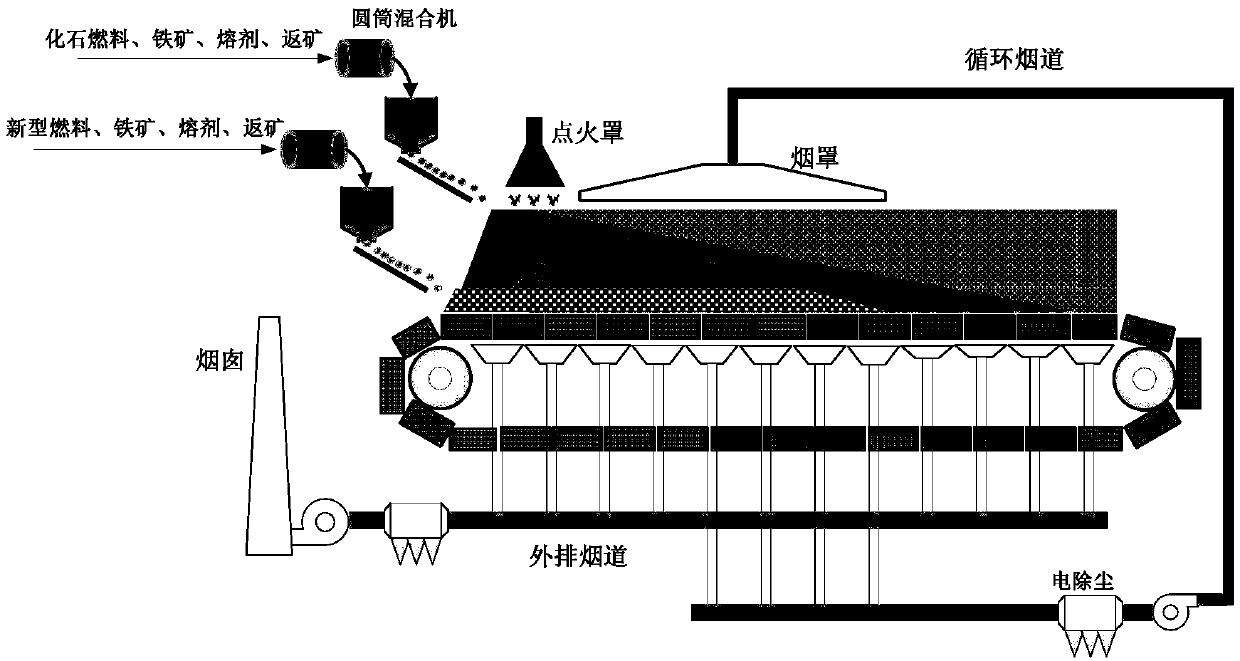Low-carbon and low-NOx sintering method based on reasonable distribution of fuel
A sintering method and fuel technology, which are applied in the fields of iron ore sintering and low-carbon and low-NOx sintering, can solve the problems of less than 10% utilization rate and waste of resources, and achieve the effects of reducing solid fuel consumption, reducing NO emission and sufficient combustion
- Summary
- Abstract
- Description
- Claims
- Application Information
AI Technical Summary
Problems solved by technology
Method used
Image
Examples
Embodiment 1
[0031]Iron ore, flux, returned ore, and straw charcoal (respectively see Table 1 and Table 2 for physical and chemical properties and particle size composition) are batched according to mass percentages of 60%, 12%, 25%, and 3%. After mixing and granulating, they are distributed in the In the material layer at the lower part of the sintering machine, iron ore, flux, returned ore, and coke powder (see Table 1 and Table 2 for physical and chemical properties and particle size composition respectively) are batched according to mass percentages of 58%, 12.5%, 25%, and 4.5%. After mixing , After granulation, it is distributed in the lower material layer of the sintering machine; the flue gas with a CO concentration of 2.0% in the bellows in the middle of the sintering machine is circulated back to the sintering material surface, the number of bellows accounts for 20% of the total number of bellows, and the coverage area accounts for 30% of the length of the sintering machine %. The...
Embodiment 2
[0033] Iron ore, flux, returned ore, and charcoal (see Table 1 and Table 2 for physical and chemical properties and particle size composition, respectively) are batched according to mass percentages of 65%, 12%, 20%, and 3%. After mixing and granulating, they are placed in sintered The lower material layer of the machine, iron ore, flux, return ore, and coke powder (see Table 1 and Table 2 for physical and chemical properties and particle size composition respectively) are batched according to mass percentages of 60%, 12.5%, 23%, and 4.5%. After mixing, After granulation, it is distributed in the lower material layer of the sintering machine; the flue gas with a CO concentration of 1.8% in the bellows in the middle of the sintering machine is circulated back to the sintering material surface, the number of bellows accounts for 25% of the total number of bellows, and the coverage area accounts for 35% of the length of the sintering machine . The schematic diagram of the impleme...
Embodiment 3
[0035] Iron ore, flux, returned ore, and charcoal (see Table 1 and Table 2 for physical and chemical properties and particle size composition respectively) are prepared according to mass percentages of 63%, 12%, 22%, and 3%. The material layer in the lower part of the machine, iron ore, flux, return ore, coke powder (see Table 1 and Table 2 for physical and chemical properties and particle size composition respectively) are batched according to mass percentage 59%, 12.5%, 24%, 4.5%, after mixing, After granulation, it is distributed in the lower material layer of the sintering machine; the flue gas with a CO concentration of 2.2% in the bellows in the middle of the sintering machine is circulated back to the sintering material surface, the number of bellows accounts for 30% of the total number of bellows, and the coverage area accounts for 45% of the length of the sintering machine . The schematic diagram of the implementation of material split granulation, layered distributio...
PUM
| Property | Measurement | Unit |
|---|---|---|
| particle size | aaaaa | aaaaa |
Abstract
Description
Claims
Application Information
 Login to View More
Login to View More - R&D
- Intellectual Property
- Life Sciences
- Materials
- Tech Scout
- Unparalleled Data Quality
- Higher Quality Content
- 60% Fewer Hallucinations
Browse by: Latest US Patents, China's latest patents, Technical Efficacy Thesaurus, Application Domain, Technology Topic, Popular Technical Reports.
© 2025 PatSnap. All rights reserved.Legal|Privacy policy|Modern Slavery Act Transparency Statement|Sitemap|About US| Contact US: help@patsnap.com


